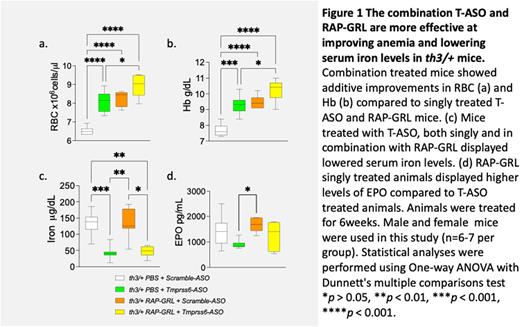Abstract
The hallmarks of β-thalassemia (BT) include ineffective erythropoiesis (IE) and iron overload (IO). Our studies have pointed to iron restriction (IR) to improve both anemia and IO in BT. One such IR therapy targets the matriptase-2 (TMPRSS6) gene using antisense oligonucleotides (ASO). As shown by Guo et al JCI 2013, treatment of Hbbth3/+(th3/+) mice (a BT mouse model for BT-intermedia) with TMPRSS6-ASO (T-ASO) lengthens RBC lifespan, ameliorates splenomegaly and improves anemia.
A novel therapeutic approach to improve anemia targets the TGF-β pathway to promote red blood cell (RBC) production. Luspatercept, a Transforming Growth Factor (TGF)-β ligand-trap that is modeled after the extracellular domain of activin receptor (ACVR)-2B, gained FDA approval in 2019 to treat transfusion dependent BT patients (Cappellini and Taher Blood Adv, 2021). In mouse models of BT, its murine analog (RAP-536) was suggested to promote erythropoietin (EPO) independent maturation of late-stage erythroid cells, resulting in increased RBC parameters in a dose-dependent manner (Surgani et al Nat. Med., 2014). In clinical trials, the drug has been shown to improve anemia and reduce the need for blood transfusion in BT. However, despite its success, it does not improve anemia in all patients. Therefore, we hypothesized that a combinatorial approach could be more effective, and potentially beneficial to a greater number of patients.
In this work, we explored a combination approach using an agent analogous to murine Luspatercept (RAP-GRL) and iron restriction (IR) using T-ASO, with the goals of targeting distinct morbidities associated with BT and further improve anemia.
To test our construct, RAP-GRL was produced in a mammalian cell line and purified. Wild-type (WT) or th3/+ mice were subcutaneously (s.c.) injected with 10mg/kg of RAP-GRL and monitored by complete blood counts. Treatment with purified RAP-GRL increased RBC parameters in both WT and th3/+ mice (n=3-9, 2-4-month-old females and males).
In combination therapy experiments, we injected s.c. with 10mg/kg of RAP-GRL and/or 5mg/kg T-ASO via intraperitoneal (i.p.) injection in th3/+ mice. At the experimental end point (6 weeks), RBC parameters were increased in all treatment groups, except in controls treated with PBS+Scramble-ASO (Fig.1a-b).
Flow cytometry analysis using CD71, TER119, and CD44 antibodies showed improvements of ineffective erythropoiesis in the bone marrow (BM) and spleen (SPL) of all treatment groups compared to control PBS+Scramble-ASO treated animals. In addition, our data suggest that RAP-GRL does not directly modulate systemic iron metabolism (Fig.1c). Additionally, ROS levels and splenomegaly were also greatly reduced in T-ASO and RAP-GRL+T-ASO groups. Serum assessment of T-ASO and RAP-GRL+T-ASO treated animals showed decreased levels of transferrin saturations with a simultaneous increase in hepcidin levels, but not in the RAP-GRL treated groups. Erythroferrone (ERFE) levels were decreased in all T-ASO and RAP-GRL+T-ASO groups. However, compared to th3/+ T-ASO treated mice, EPO levels were increased in the RAP-GRL treated group (Fig.1d). Additionally, although EPO was relatively elevated in all RAP-GRL treated groups, only the RAP-GRL+T-ASO group had reduced ERFE. This result is in agreements with our findings of decreased early (ERFE-producing) erythroid progenitors in the BM and SPL of RAP-GRL+T-ASO treated mice. Interestingly, our data also highlight the superior ability of T-ASO in improving erythroid maturation, especially considering the reduced EPO requirement.
Preliminary RBC metabolomic data shows differences in redox metabolites, coenzymes and metabolites involved in protein synthesis of both RAP-GRL and T-ASO singly treated groups with additive effects in the combination group, in line with the observed improved RBC quality and survival. Further analyses are under way.
In conclusions, we observed that T-ASO is superior in reducing EPO requirement, improving iron metabolism and red cell differentiation, while RAP-GRL increases overall RBC production. Their combination maintains these positive endpoints, but also is also superior in improving RBC and Hb synthesis, with a significant improvement in the anemia. This study provides the first pre-clinical support for combining these two drugs to improve anemia as well as iron metabolism in BT patients.
Disclosures
Rivella:BVF Partners L.P: Consultancy; Cambridge Healthcare Res: Consultancy; Catenion: Consultancy; Celgene: Consultancy; Disc Medicine: Current holder of stock options in a privately-held company, Membership on an entity's Board of Directors or advisory committees; First Manhattan Co: Consultancy; FORMA: Consultancy; Ghost Tree Capita: Consultancy; Incyte: Membership on an entity's Board of Directors or advisory committees; Ionis Pharmaceuticals: Membership on an entity's Board of Directors or advisory committees; Keros Therapeutics: Consultancy; MeiraGTx: Consultancy; Noble insight: Consultancy; Protagonist Therapeutics: Consultancy; Rallybio, LLC: Consultancy; Sanofi Aventis U.S: Consultancy; Slingshot Insight: Consultancy; Techspert.io: Consultancy; venBio Select LLC: Consultancy; Vifor: Membership on an entity's Board of Directors or advisory committees.
Author notes
Asterisk with author names denotes non-ASH members.


This feature is available to Subscribers Only
Sign In or Create an Account Close Modal